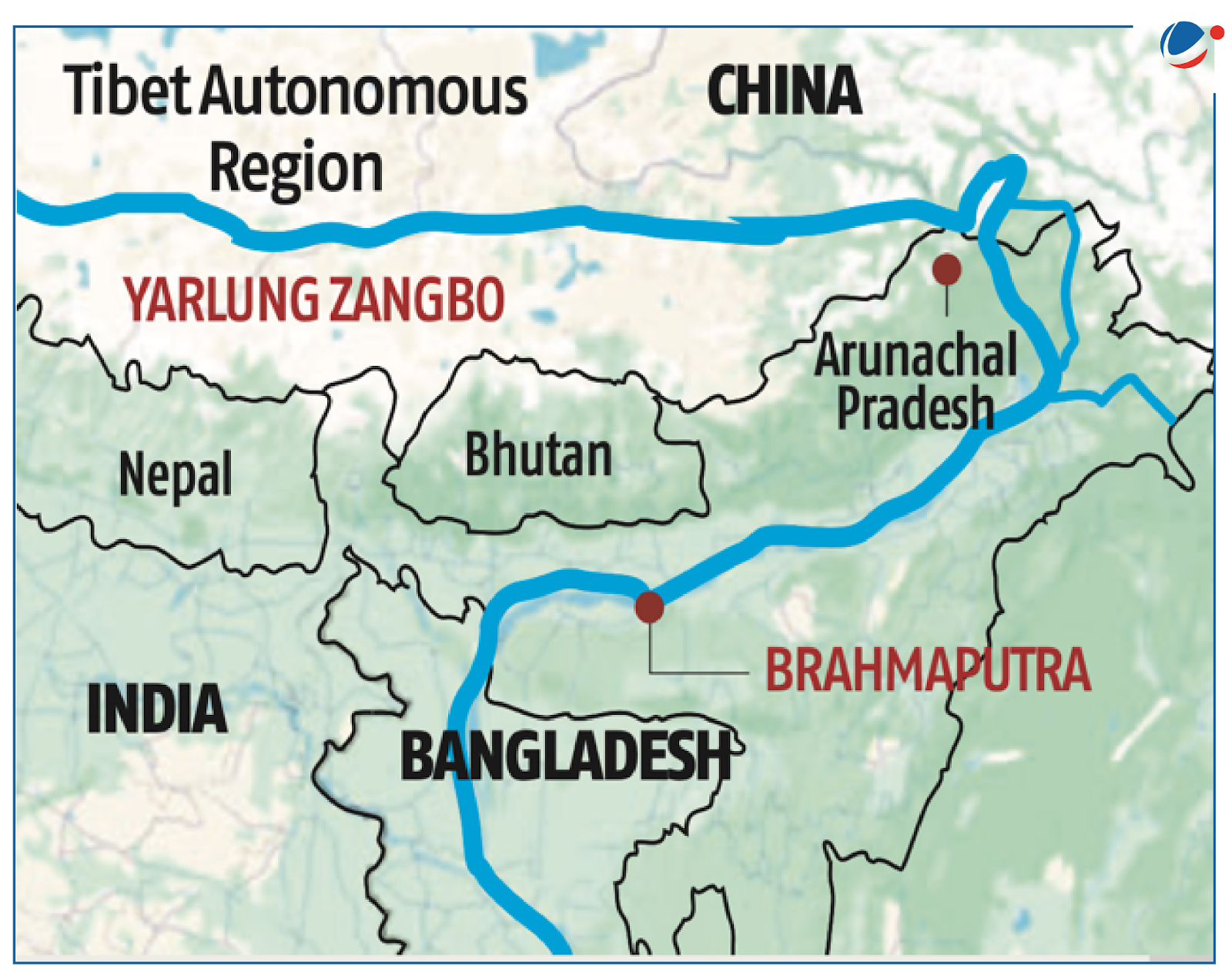China has officially commenced the construction of its "super hydropower dam" on Brahmaputra river in Tibet region.
China's announcement of the mega dam project on the Brahmaputra river, also known as Yarlung Tsangpo river. This infrastructure undertaking represents more than just an energy project. It embodies the complex dynamics of water security and the evolving nature of India-China bilateral relations in the 21st century.

Understanding the Mega Dam Project
Scale and Strategic Positioning
The project consists of five cascade hydropower stations with a total investment of 1.2 trillion Yuan, making it the world's biggest infrastructure project. The dam will be positioned at the lower reaches of the Yarlung Tsangpo (Tibetan name for Brahmaputra) at a massive gorge where the river makes a dramatic U-turn before flowing into India's Arunachal Pradesh.
With over three times the capacity of China's Three Gorges Dam, the project is expected to generate more than 300 billion kWh of electricity annually, sufficient to meet the power needs of over 300 million people. Also, the positioning of the dam in Tibet's rugged terrain provides China significant leverage over water flows that sustain millions downstream in India and Bangladesh.
Geopolitical Context
The project is in line with China's broader Belt and Road Initiative and its growing assertiveness in regional infrastructure development. The dam's location in the sensitive Medog region of Tibet, close to the Indian border, underscores how infrastructure projects have become instruments of statecraft in contemporary international relations.
China’s Energy Security and Water Resource Control
Beijing frames this initiative within its carbon neutrality goals, emphasizing the project's role in generating clean, renewable energy. The mega dam aligns with China's commitment to achieve carbon neutrality by 2060. The project will primarily deliver electricity for external consumption while addressing local demand in Tibet.
Beyond energy generation, the project provides China with unprecedented control over transboundary water resources, serving as both an economic asset and a strategic tool in future negotiations with downstream neighbors. This dual-purpose nature reflects China's sophisticated approach to leveraging development projects for broader geopolitical objectives.
Bilateral Relations Under Stress
Water Diplomacy Deficit
The China mega dam project highlights the absence of water-sharing agreements between China and India. There is also a lack of institutional frameworks for managing transboundary river disputes.
Currently, the Expert Level Mechanism (ELM) established in 2006 serves as the primary framework, under which China provides India with hydrological data on Brahmaputra and Sutlej rivers during flood seasons. However, this limited arrangement falls short of addressing the complexities posed by major infrastructure projects.
China's historically limited approach to information sharing regarding upstream projects creates trust deficits that complicate diplomatic negotiations. The lack of transparency regarding dam operations, water release schedules, and comprehensive environmental impact assessments undermines regional cooperation possibilities.
Strategic Competition Dimensions
This development occurs against the backdrop of broader India-China strategic competition, from the Line of Actual Control disputes to economic rivalry. Water resources serve as another dimension of this complex relationship, where infrastructure development becomes both a source of leverage and potential conflict.
Regional Impact Assessment
Downstream Vulnerabilities
India and Bangladesh face legitimate concerns about China's ability to control water flow, particularly fears about the dam's potential use to release excess water during conflicts, causing floods. The uncertainty of water releases from the upstream dam could disrupt traditional farming cycles, affecting millions of livelihoods dependent on predictable water flows.
Northeastern India's Exposure
Assam and Arunachal Pradesh, which depend heavily on Brahmaputra flows for agriculture and fisheries, face particular vulnerability. The potential for floods through sudden water releases poses risks to existing infrastructure, while reduced water flows during dry seasons could hamper irrigation and power generation projects. It may also impact the livelihood of tribals such as the Adi tribe in the Siang region of Arunachal Pradesh.
Regional development challenges extend to national security concerns, as water availability becomes intertwined with regional stability and potential cross-border population movements. Climate change impacts, combined with upstream water control, create compounded vulnerabilities for this strategically important region.
Engineering and Environmental Challenges
The dam faces significant engineering challenges due to its location on the Tibetan plateau, frequently experiencing earthquakes as it sits over active tectonic plates. This geological instability poses risks to the structural integrity of what will be the world's largest dam.
The construction threatens potential disruption to local ecology and downstream water flow patterns, with risks of altering the river's natural course and affecting regional agriculture and biodiversity. The dam's environmental impact must be evaluated within the broader context of Himalayan climate change, where glacial melt acceleration initially increases water flows but ultimately threatens long-term regional water availability.
India's Potential Responses
- India is also building its hydropower dam on the Brahmaputra in Arunachal Pradesh, representing a strategic response to China's upstream advantage.
- India must intensify efforts to establish formal water-sharing protocols and transparency mechanisms with China.
- Strengthening trans-boundary river cooperation between the riparian countries ⎼ China and Bangladesh creates opportunities for negotiations and consensus.
- International partnerships with countries facing similar transboundary water challenges provide additional diplomatic support and technical expertise.
- Leveraging technologies like satellite monitoring, artificial intelligence, and big data analytics for tracking water flows and predicting environmental impacts can enhance transparency and build confidence between upstream and downstream nations.

Conclusion
The Brahmaputra River's future, along with India-China relations, faces a significant juncture due to China's colossal dam project. The development underscores the need for robust frameworks governing transboundary water resources in South Asia, where rivers serve as lifelines for hundreds of millions of people.
For India, this challenge demands a multifaceted response combining diplomatic engagement, infrastructure development, and regional cooperation. The country's approach to this issue will significantly influence broader bilateral relations with China while setting precedents for managing similar challenges across shared river systems.
The project's implications extend beyond immediate hydrological concerns to encompass regional stability, economic development, and environmental sustainability. Success in addressing these challenges requires sustained commitment to multilateral cooperation, technological innovation, and adaptive management strategies that can respond to evolving geopolitical and environmental conditions.
Master India-China Relations & Regional Security Analysis with VisionIAS Comprehensive Current Affairs →